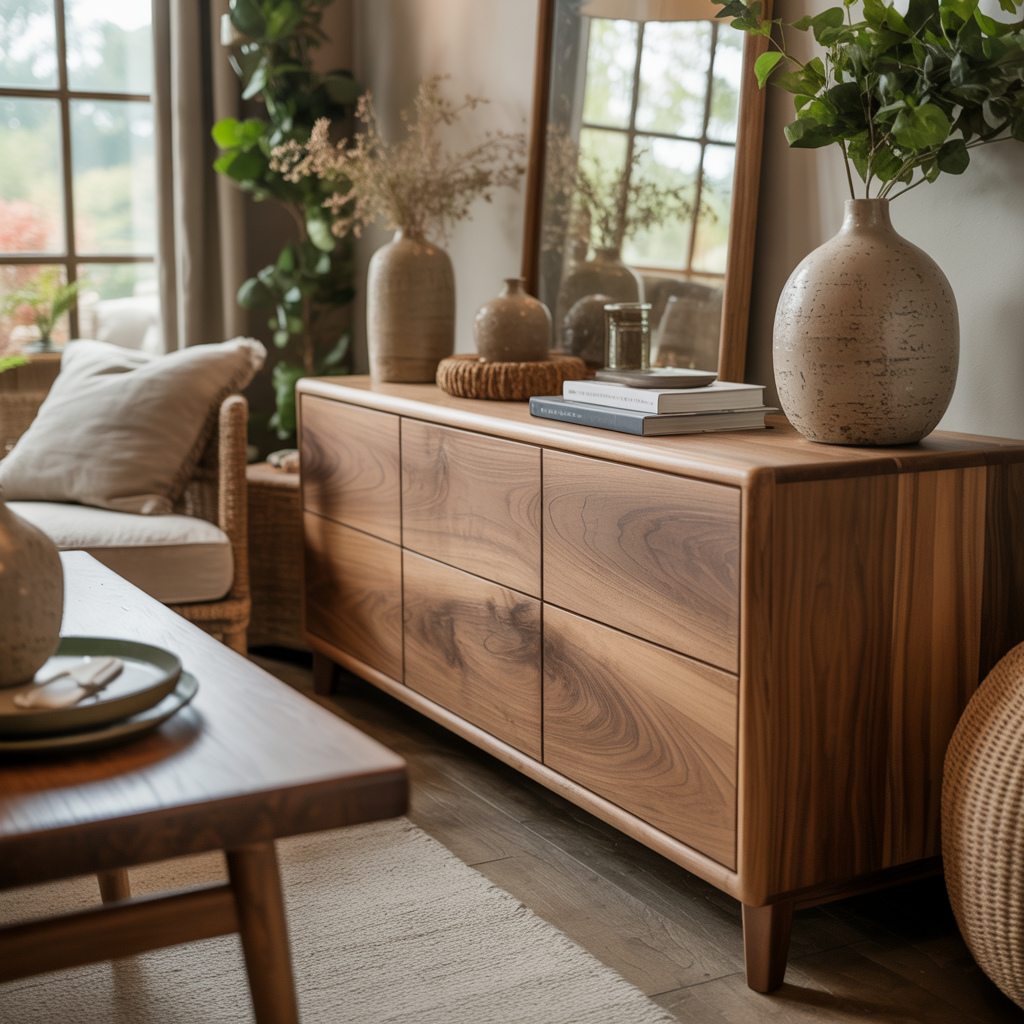Storage Cabinet & Decor Ideas
Natural Wood Cabinets: Warmth, Texture & Timeless Appeal
1. The Enduring Beauty of Wood
Natural wood has a tactile richness that no laminate or engineered material can fully replicate. The visible grain, subtle color variations, and organic imperfections tell a story of growth and craftsmanship. Whether oak, walnut, ash, or teak, every species introduces a unique tone and rhythm to your space. In modern interiors, wood softens geometry and adds warmth to clean lines. When paired with glass, metal, or concrete, it becomes a grounding element — balancing the sleek with the organic. This harmony makes natural wood cabinets ideal companions to your coffee tables, TV stands, and side tables.
2. Choosing the Right Wood Type
- Oak: Durable and versatile, with a visible grain that brings a classic yet modern tone.
- Walnut: Deep brown hues and smooth grain offer a refined, luxurious look.
- Ash: Pale, clean wood ideal for Scandinavian or minimalist homes.
- Teak: Rich and weather-resistant, perfect for high-traffic areas or warm climates.
The choice of wood influences not just aesthetics but also how light interacts with your interior. Lighter woods make compact spaces feel airy, while darker tones ground open-plan layouts.
3. Finishes That Enhance Natural Character
The finish determines how wood looks and feels — whether matte, satin, or oiled. A natural matte finish maintains texture and showcases the grain, while oil finishes deepen color and highlight tone variation. Lacquer adds a subtle sheen for a contemporary touch. To protect the surface while retaining authenticity, choose low-VOC natural oils or waxes. They nourish the wood without sealing it completely, allowing it to age gracefully.
4. Function Meets Form
A storage cabinet is most beautiful when it works intelligently. Soft-close drawers, adjustable shelves, and hidden compartments preserve minimalism while supporting everyday use. Combining open and closed sections creates balance — conceal essentials, display what you love. Explore refined designs in our Storage Cabinets collection — each piece built with durability, function, and timeless proportion in mind.
5. Styling Wood Cabinets in Modern Spaces
The beauty of natural wood cabinetry lies in how it interacts with light and texture. Place your cabinet where natural sunlight enhances its tone. Complement the wood’s hue with décor elements — linen, ceramic, stone, or woven fiber — to accentuate its organic appeal.
- Use neutral walls and soft lighting to highlight the grain.
- Decorate with sculptural objects or greenery for contrast.
- Keep styling minimal — let the craftsmanship speak for itself.
For inspiration on balancing texture and proportion, browse our editorial piece Storage Cabinet & Decor Ideas.
6. Pairing with Other Furniture
To create a cohesive environment, coordinate your wood cabinet with other key pieces. Match tonal families rather than exact finishes — this creates depth rather than monotony. For example:
- Pair a dark walnut cabinet with a light ash coffee table for visual contrast.
- Use complementary materials such as glass or metal legs to modernize traditional wood furniture.
- Keep the flow consistent with similar hardware finishes or repeated vertical lines.
For layout guidance and spacing, see End & Side Table Design & Placement Tips — it applies equally to larger storage pieces.
7. Lighting and Mood
Lighting enhances the tactile beauty of natural wood. Warm, diffused light emphasizes depth and texture. Try using lamps or sconces near your cabinets instead of harsh overhead lighting. The glow amplifies wood’s organic tones, bringing intimacy to your living room or dining area. Integrate cabinet lighting carefully — hidden LED strips or soft interior illumination can transform storage into an elegant display.
8. Caring for Natural Wood Cabinets
With proper care, solid wood ages beautifully. Dust weekly with a soft, dry cloth. Avoid chemical sprays — instead, use natural oil blends occasionally to restore moisture. Protect surfaces from direct heat or long exposure to sunlight, which may cause fading over time. Remember that small marks and tone shifts are part of the story. Wood patinas with age, adding authenticity and depth that artificial finishes can’t mimic.
9. The Timeless Appeal
In a fast-changing world, natural wood endures. It feels human, grounding, and enduringly relevant. Its imperfections are its beauty; its adaptability is its strength. From modern apartments to rustic villas, wood cabinetry bridges eras and styles — always warm, always timeless. For full-room inspiration, explore complementary guides like TV Stand Style & Function Guide and Coffee Table Inspiration & Styling Ideas. Each shows how wooden textures unite living spaces into cohesive, nature-inspired sanctuaries.
Final Thoughts
Natural wood cabinets celebrate the artistry of material honesty. They offer storage that feels alive — transforming ordinary interiors into serene, tactile environments. Whether oak, walnut, or teak, wood carries a story of craftsmanship and time, one that matures gracefully with every year.

